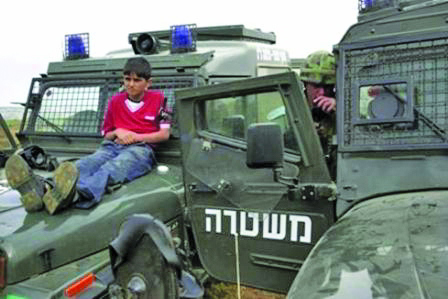
The term human shield is not only an expression in military parlance during modern-day conflict, but is a well-used expression during mythological times. During the epic Mahabharata conflict there was the incident of Shikhandi when a protected person, a eunuch, off-limits to both sides, was used as a shield by the Pandavas to carry out an attack on Bhishm Pitamah. Bhishm Pitamah refused to retaliate as he would have hit Shikhandi, and was thus killed by Arjun. This act by the Pandavas was considered a war crime. Human shield is a military and political term where human beings are placed in front or around a military target so that the opposing force is deterred from carrying out an attack on the target in question.
Modern history is replete with incidents of the use of human shields for military gain. In the World War II, the German Army, specially the SS, used Prisoners of War (POWs) to protect the military locations from attack or civilians as shields while launching an attack during their Polish campaign. In 1944, they put Polish women on their tanks as human shields. In Belgium, the Germans used civilians to protect themselves from Allied fire while crossing an important bridge in the tactical battle area. Similarly, Japanese used their own civilians as human shields against attacks by American bombers.
In the Mahabharata, Arjun used the cover of Shikhandi, who was off-limits to both sides, to carry out an attack on Bhishm Pitamah and kill him.
The list goes on to the war in Korea, Lebanon in 1982, Persian Gulf war of 1990-91, the Serbian attack against Bosnia and the war in Afghanistan where the Taliban used their own population as human shields against coalition forces in 2006 and 2007. During the Israel-Palestinian conflict, according to Israeli officials, Palestinians used human shields on 1,200 occasions, during the war in Gaza from 2008 to 2014. In Lebanon, Hezbollah used Lebanese civilians as human shield against the IDF forces and in more recent conflicts we have seen this in Sri Lanka, Crimea and Syria.
In legal terms, Rule 97 of the Customary Law states that the use of human shields is prohibited in both International and non-International armed conflicts. In International armed conflicts, this rule is covered in the 3rd Geneva Convention which deals with the protection of POWs, and the fourth Geneva Convention which deals with the protection of civilians during conflicts. The Statute of the International Criminal Court clearly states that “utilizing the presence of civilian or other protected person to render certain point areas or military forces immune from military operations “constitutes a War Crime in International armed conflict”.

All across the world, a number of military manuals prohibit the use of human shields and most of these extend this prohibition to all civilians. Besides, many states list the practice of human shield as a criminal offence in their legislation. This has been upheld by various military tribunals and trials; by the UK Military Court at Luneberg in 1946, by the US Military Tribunal at Nuremberg in 1948, and in the Kardzic and Mladic case—pertaining to former Yugoslavia—before the International Criminal Tribunal in 1995.
However, in case of Non-International armed conflict, Protocol 2 does not directly mention the use of human shield but certainly supports the requirement of protecting the population from dangers arising from military operations. The use of human shields has been equated with the taking of hostages which is prohibited by Additional Protocol 2 and by the Customary International Law.
Besides, all military commanders are well-versed with the Principles of Armed conflict. The principle of “Distinction” will certainly be considered where it is the duty of the military commander to separate the civilians from military objective/action. The principle of “military necessity” would ask the military commander how was it the requirement of his military to create a human shield/hostage situation. The use of human shields has been condemned by a number of states and the United Nations, as was evident in the conflicts in Sierra Leone, Somalia, Rwanda, Liberia, former Yugoslavia and Tajikistan. When we talk of Human Rights, the International Human Rights Law does not directly prohibit the use of human shield but if carried out, would certainly violate the Right to Life. The right has to be protected by the state machinery.
In the case of Major Gogoi, the army says it was in a situation of maintaining law and order, and there was no conflict—International or Non-International—hence no Geneva Convention or additional protocol is applied. The youth were violent and it required a careful handling with minimum or no force applied, and this was carried out by Major Gogoi with not a single bullet fired or a single drop of blood spilled. If tying him to the jeep was denying him his human rights, then this should be clarified by the critics.
—The author is a Defence and Security Analyst


